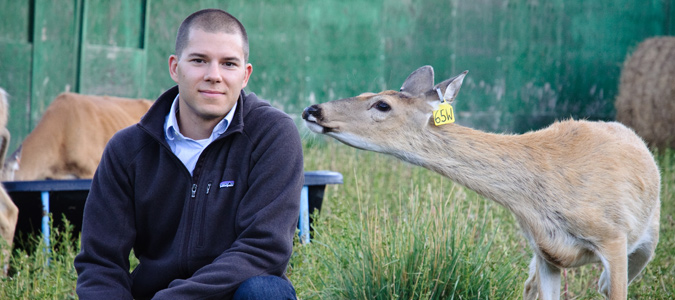Battling chronic wasting disease in Elk and Deer
Chronic wasting disease (CWD) has been responsible for the severe decline of Saskatchewan’s game farm industry. Millions have been spent on programs to screen herds and compensate farmers.
By Mark Ferguson At present, the only way to control the disease has been through culling farmed herds and thinning wild populations through hunting. Still, the disease continues to spread.
At present, the only way to control the disease has been through culling farmed herds and thinning wild populations through hunting. Still, the disease continues to spread.Now University of Saskatchewan research scientists and colleagues at University of British Columbia have been awarded $428,000 from PrioNet Canada to develop an oral vaccine against CWD in elk and deer. The team hopes the vaccine will be available within five years.
"This vaccine will be an important tool for the control of CWD," says Scott Napper, a research scientist at the U of S Vaccine and Infectious Disease Organization.
U of S PhD student Ryan Taschuk is spearheading the effort to formulate the oral vaccine and carry out trials on deer. These trials are scheduled to begin in early fall.
Some of this work may be done at the U of S International Vaccine Centre (InterVac), Canada's largest containment level 3 facility, which opens September 16.
"InterVac will greatly increase the potential of vaccine research in Canada," says Ryan. "With this world-class facility, developing vaccines against diseases like CWD can be safely conducted in the most efficient way possible."
CWD is caused by an infectious form of the prion protein and affects elk and deer populations. The hope is that the research on CWD can also be used to develop vaccines against other prion diseases that affect humans, such as mad cow disease.
The challenge is to produce not only an effective vaccine, but one that deer and elk will voluntarily eat in the wild.
The vaccine will be given in a food packet that will be consumed by animals, and consequently immunize them against the disease. This food packet baiting approach has been used effectively in Ontario against rabies.
"These efforts keep Ryan busy investigating different vaccine formulations in the lab and pondering questions of dietary habits to ensure the final product will be both effective and appealing for the deer," says Napper.
Since its discovery in Colorado 50 years ago, CWD has become endemic throughout Saskatchewan, Alberta, and numerous U.S. states, and has had a devastating effect on wild and farmed elk and deer populations.
The route by which CWD is spread is not entirely known, but it is thought that it is transmitted through feces, urine, and saliva.
"One key aspect of CWD transmission is that excreted infectious prions from diseased animals become more infectious when they contact the soil which leads to further spread within the population," Taschuk said.
Prion proteins occur naturally in the body, but in the case of CWD, mad cow, and other prion diseases, they become misfolded, leading to accumulation in the central nervous system of their hosts and eventually causing death.
Though researchers still have not determined the function of the healthy prion, they know the diseased form can hijack healthy prion proteins causing them to also become diseased.
Napper and his team are working to design a vaccine against CWD by specifically targeting the disease-causing prions, while sparing the naturally occurring prions in the host.
Though historically there has never been evidence of CWD transmission to humans, Napper says the future possibility of human transmission cannot be ruled out.
"What researchers are finding is that prions are evolving, just like bacteria and viruses do. They are a dynamic entity, and without a vaccine there is great risk for transmission to other animals, including humans."
Tara Donovan is a graduate student writer for the U of S research communications office.
http://www.usask.ca/research/

